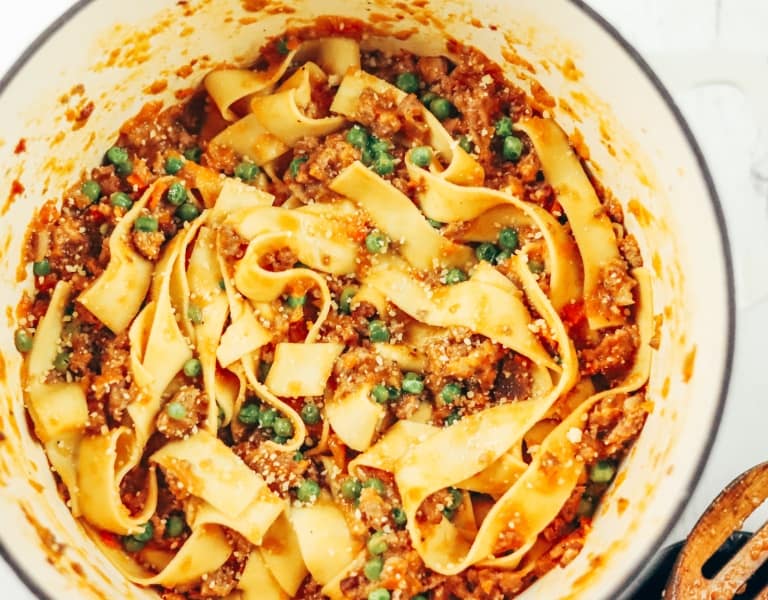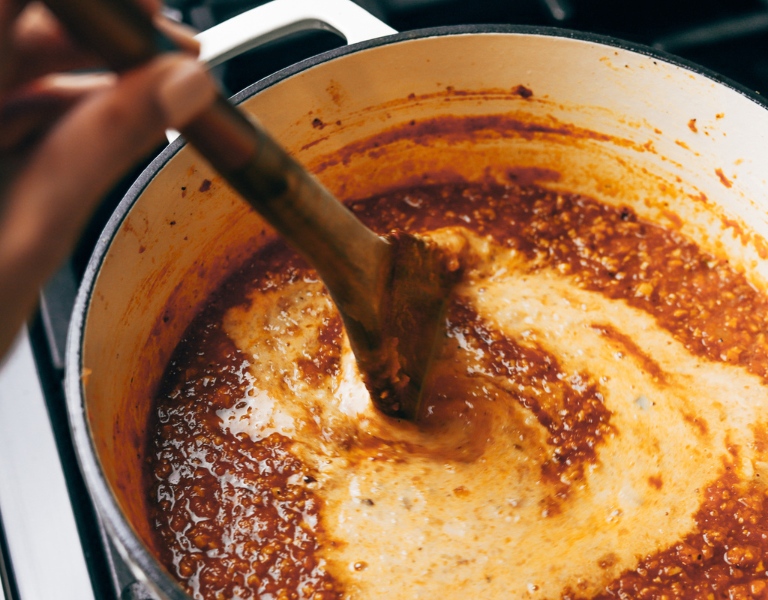
This tagliatelle alla Bolognese recipe is the ultimate comfort food dish! The recipe features ground chicken sausage, pancetta, classic Mirepoix, white wine, and tomato paste. Bolognese is also known as ragù alla Bolognese, originating in Bologna, Italy. Being a product of Northern Italy, it is not considered a tomato sauce but a slow-simmered meat sauce with a small amount of tomato paste.
I’ve made several variations of a classic Bolognese and always return to this one. I won’t claim it to be the “authentic” Bolognese sauce (the “real” Bolognese is still up for debate), but it’s pretty darn close. Many of the classic ingredients make an appearance, with the addition of freshly crushed garlic and swapping beef for chicken Italian sausage to make a chicken sausage Bolognese.
What is Bolognese?
Classic Bolognese is not a red sauce; it is a slow-cooked meat sauce. Northern Italian cuisine features wine- or stock-based sauces that are often slowly braised. The tomato in Bolognese is just a heaping scoop of tomato paste. Additionally, you’ll need to use about a half-cup of dry white wine and three to four cups of chicken stock for the rest of the base.

The general rule to follow when cooking with wine is this: if you’d drink it, cook with it. However, please don’t cook with anything too fancy—this merely pertains to the idea that you shouldn’t cook with a wine you wouldn’t enjoy.
How to make Bolognese
Bolognese is a slow-braised meat sauce, which takes about three hours to cook. The great part about this cooking time is that you don’t have to be completely active for the duration of its braising. Once you’ve prepared all of your ingredients and have the sauce simmering, simply stir the sauce occasionally while ensuring that it hasn’t lost too much of its liquid.
What kind of pan is best for Bolognese?
The number one choice for cooking at least four servings of Bolognese is going to be a Dutch oven. I use a five-quart enameled cast iron Dutch oven for just about every “pot” meal, including Bolognese.
If you’re using cast iron, be sure to use one that’s enameled. Sauces and foods with too much acidity can break down the metallic molecules in your cast iron pan or Dutch oven and—even worse—break down the seasoning you’ve spent years acquiring. You can read more about what not to cook in your cast iron pan.
Best meat for tagliatelle alla Bolognese
In a classic Bolognese with beef, you allow the slow braising of the ground beef to break down during a slow simmer. However, chicken doesn’t behave the same way as beef. Enter the food processor.

Start out by browning your chicken sausage in the Dutch oven and then carefully transfer it to a bowl. A few simple pulses in the food processor will break up the sausage, once browned, to give you the consistency of a slow-braised beef Bolognese.
Bacon or pancetta in Bolognese?
To achieve the richness of Bolognese, you’ll need to choose your pork option. Traditionally, a few slices of pancetta are used to obtain this slow-cooked savoriness. But, if you don’t have pancetta or prefer to use bacon, you can do so—just make sure to use the right kind.

Avoid any breakfast bacon (like maple) and opt for something milder. You can ask your butcher for clarification; they’ll know the most about the types of bacon on hand! I find it easiest to use pre-cubed pancetta, which I often find at places like Trader Joe’s and Whole Foods.
How to make Mirepoix
Mirepoix is a traditional French flavor base made with carrots, onions, and celery. But isn’t this Italian, you ask? Well, yes! Northern Italian cuisine has several influences from neighboring France, including stock and wine-based feasts and flavors from the mirepoix.
The easiest way to achieve your Mirepoix is to utilize your food processor. (If you don’t have one, you can simply finely chop these vegetables.) Rough-chop the onion, celery stalks, and carrots, and pulse chop until the combination becomes very fine.

You can add your Mirepoix directly into your cooked bacon or pancetta, taking advantage of its fat renderings and salty/smoky characteristics. If you’re cooking with Italian or seasoned sausage, keep salt and pepper seasoning to a minimum.
How to cook the Bolognese
Once you’ve incorporated the chicken sausage, pork, and mirepoix, you’ll want to add your wet ingredients and get your Bolognese simmering.
Depending on how long you braise the Bolognese, you’ll need anywhere between two and three cups of chicken stock. Start out with two cups of stock and your half-and-half or milk. While stirring occasionally, you’ll notice if it becomes too dense or sticky.
Simply add a splash of stock at a time until it’s more saucy. You want it to be rich and creamy, but not too dense. If you’re adding frozen peas, you’ll want to do this about 30 minutes before it’s done.

If you’ve used all three cups of stock and still want more fluid, you can incorporate a ladle or two of pasta water.
Cook your pasta to al dente (or slightly before), add one or two ladles of pasta water, and drain the pasta. You can also use a spider strainer to transfer the pasta to the sauce.
Add the pasta to your Bolognese and let simmer for 10 minutes with the lid on your Dutch oven or pot. Be sure to add your Parmigiano Reggiano only a few minutes before adding your pasta.

What pasta goes with Bolognese?
Typically, Bolognese is made using Tagliatelle, a wide egg noodle (hence the recipe, Tagliatelle alla Bolognese!). However, you can use several types of pasta, depending on your preference.
- Pappardelle
- Fettuccine
- Rigatoni
- Penne
- Wide egg noodle
- Extra wide egg noodle

What to do with leftover tagliatelle alla Bolognese?
Ideally, you’ll make more than enough pasta and Bolognese for leftovers. I enjoyed this dish as a late-night dinner and breakfast the next morning. Divvy up the pasta into single servings and store in a glass or medium-sized airtight container.
When reheating, add a splash of chicken stock and warm up in a pot over the stove or covered in the microwave. Add 1-2 teaspoons of Parmigiano Reggian after heating and gently stir.
The pasta will have absorbed some of your sauce, so the additional stock and cheese will bring back the rich creamy texture to your Tagliatelle alla Bolognese.
Can you freeze Bolognese sauce?
Absolutely, you can freeze your Bolognese. Typically, Bolognese can be frozen for up to three months. There are a few ways to freeze your sauce, but I like the zip-lock bag trick.
- Allow the Bolognese to cool (you don’t want it steaming or fresh off the stove).
- Divide it into quart or gallon freezer bags, filling about one-third full.
- Close the bags almost completely before lying them flat on the counter.
- Carefully press on the bags, distributing the sauce and removing any air from the bags. Then, seal completely.
- Freeze the bags flat side down; you can later “file” these bags or easily store them flat.
Storing your Bolognese sauce flat in freezer bags allows you easier storage and quicker defrosting times!
What to serve with Bolognese?
Bolognese goes well with a classic salad and a side of bread. Whether it’s homemade sourdough, rolls, or garlic bread, a slice of something to soak up the extra sauce is a must! For reference, I always serve my Tagliatelle alla Bolognese with a Caesar salad and slices of fresh homemade garlic rosemary sourdough loaf.
How long does Bolognese last in the fridge?
Bolognese will last about three or four days in the fridge. As mentioned above, it stores best when divided into single-servings.
Print
Tagliatelle alla Bolognese with Chicken Sausage
- Total Time: 3 hours
- Yield: 6
Description
Hearty Bolognese with tagliatelle pasta and chicken sausage.
Ingredients
-
1 lb of chicken Italian sausage
-
2 tablespoon Extra virgin olive oil
-
4 oz pancetta
-
1 large carrot, peeled
-
2 celery stalks
-
1 red onion
-
3 cloves fresh garlic, crushed
-
½ cup white wine
-
⅓ cup tomato paste
-
3 cups low sodium chicken stock, separated
-
¼ teaspoon crushed red pepper flakes
-
1 cup half-and-half or ½ cup heavy cream
-
1 bay leaf (or 2-3 fresh sage leaves)
-
⅛ teaspoon nutmeg
-
½ cup grated or shredded parmesan plus extra for garnish
-
1 lb pappardelle, rigatoni, tagliatelle, or egg noodle
1 cup peas, optional*
Instructions
- In a Dutch oven, heat olive oil over medium heat.
- Add ground chicken sausage and break it apart. Cook until it’s just under golden brown and set aside.
- Dice bacon or pancetta into small pieces and cook over medium heat for about 10 minutes until just before it's crispy. If you’re using pre-cubed pancetta, add directly to the Dutch oven.
- While the bacon or pancetta cooks, pulse chop the carrot, onion, and celery in a food processor to make the Mirepoix. Or, use a 10 oz bag of prepared Mirepoix.
- Once the pancetta is cooked, add the Mirepoix to the pot and cook until soft, about 10-15 minutes.
- While the mirepoix is sautéing, add the chicken sausage to the food processor and pulse until finely ground.
- Add chicken sausage to the Dutch oven and increase heat to medium-high
- Add the white wine and crushed garlic and stir for 10 minutes, scraping the bottom of the pan.
- Stir in tomato paste and cook until the wine is mostly reduced.
- Add 2 cups of the chicken stock along with crushed red pepper flakes.
- Reduce the heat to low and add half-and-half, bay leaf, and nutmeg.
- Let sauce simmer on low for 2 ½ to 3 hours, stirring often. If the sauce becomes too dense, add ¼ cup of broth at a time until it reaches the desired consistency which should be thick, creamy, but allow for the pasta to absorb some of the liquid.
- Bring a large pot of water (6 quarts of salted water) to a boil. Cook pasta al dente or for 2 minutes less than the suggested cooking time.
- Remove the bay leaf and add parmesan. If using peas, add them to the sauce now.
- Transfer the cooked tagliatelle or pasta to the Dutch oven and stir well.
- Serve immediately and top with a spoonful of parmesan.
- Prep Time: 30 minutes
- Cook Time: 2 ½ hours

Leave a Reply